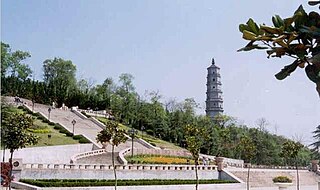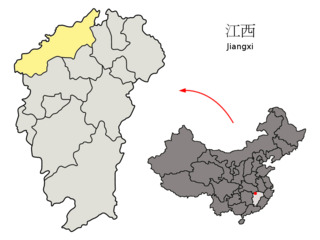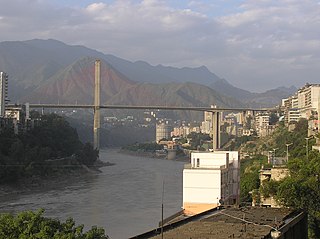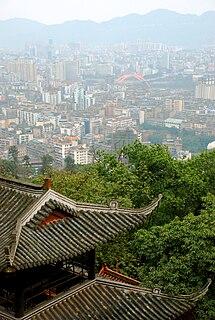 W
WAnqing is a prefecture-level city in the southwest of Anhui province, People's Republic of China. Its population was 5,311,579 at the 2010 census, with 780,514 living in the built-up area.
 W
WChizhou is a prefecture-level city in the south of Anhui province, China. It borders Anqing to the northwest, Tongling and Wuhu to the northeast, Xuancheng to the east, Huangshan to the southeast, and the province of Jiangxi to the southwest.
 W
WChongqing, alternately romanized as Chungking, is a megacity in southwest China.
 W
WEzhou is a prefecture-level city in eastern Hubei Province, China. As of the 2010 census, the city had a population of 1,048,668, of which 668,727 lived in the core Echeng District. The Ezhou - Huanggang built-up area was home to 1,035,496 inhabitants from the Echeng and Huangzhou, Huanggang Districts.
 W
WHaimen is a district of Nantong, Jiangsu province, with a population of approximately 1 million. It is located at the opposite side of the Yangtze River to Shanghai and is directly north of Chongming Island except for a small portion that forms Haimen City's Haiyong Township. Haimen is the seat of the Roman Catholic Diocese of Haimen. Haimen is located in the poorer north Jiangsu region and together with Qidong City, traditionally has one of the highest rates of liver cancer in China and in the world, with upwards of 1 out of every 10 adults in the rural areas dying from liver cancer.
 W
WHuanggang is a prefecture-level city in easternmost Hubei Province, China. It is situated to the north of the middle reaches of the Yangtze River and is bounded in the north by the Dabie Mountains and is named after Mount Huanggang. It borders Henan in the north, Anhui in the east and Jiangxi in the south.
 W
WHuangshi, alternatively romanized as Hwangshih, is a prefecture-level city in southeastern Hubei province, People's Republic of China. Its population was 2,429,318 inhabitants at the 2010 census; 1,601,687 of whom lived in the built-up area made up of 4 urban districts plus the city of Daye, now being part of the agglomeration.
 W
WJiangyin is a county-level city on the southern bank of the Yangtze River, and is administered by Wuxi, Jiangsu province. Jiangyin is one of the most important transport hubs on the Yangtze River, it is also one of the most developed counties in China.
 W
WJingzhou is a prefecture-level city in southern Hubei province, China, located on the banks of the Yangtze River. Based on the 2010 census, its total population was 5,691,707, 1,154,086 of whom resided in the built-up area comprising two urban districts.
 W
WJiujiang, formerly transliterated Kiukiang or Kew Keang, is a prefecture-level city located on the southern shores of the Yangtze River in northwest Jiangxi Province, People's Republic of China. It is the second-largest prefecture-level city in Jiangxi province after the provincial capital Nanchang. Jiujiang literally means "nine rivers".
 W
WLinxiang is a county-level city in Hunan province, China, it is under the administration of the prefecture-level city of Yueyang. The city is located on the northeastern margin of the province and on the southeastern (right) bank of the Yangtze River, it is to the east of the city proper of Yueyang. Linxiang is bordered to the northwest and the north across the Yangtze by Jianli County and Honghu City of Hubei, to the east by Chibi City, Chongyang and Tongcheng Counties of Hubei, to the south and southwest by Yueyang County, to the west by Yunxi District. It covers an area of 1,718 km2 (663 sq mi), as of 2015, it had a registered population of 537,500. The city has 3 subdistricts and 10 towns under its jurisdiction. the government seat is Chang'an (长安街道).
 W
WLuzhou (simplified Chinese: 泸州; traditional Chinese: 瀘州; pinyin: Lúzhōu; Sichuanese Pinyin: Nu2zou1; Luzhou dialect: [nu˨˩tsəu˥]), formerly transliterated as Lu-chou or Luchow, is a prefecture-level city located in the southeast of Sichuan Province, China. The city, named Jiangyang until the Southern and Northern Dynasties, is known as the "Liquor City" (酒城). Situated at the confluence of the Tuo River and the Yangtze River, Luzhou is not only an important port on the Yangtze river, but also the largest port in both size and output in Sichuan province since Chongqing seceded from Sichuan province in 1997. As of 12 31 2017 estimation, its population was 4,317,200 inhabitants whom 998,900 lived in the built-up (or metro) area made of Jiangyang and Longmatan districts, as Naxi district is not conurbated yet. Luzhou, which borders Yunnan, Guizhou and Chongqing, is the only geographic junction of the four provinces, and was therefore the logical place for a port in ancient China. After the PRC was founded in 1949, Luzhou became the capital of southern Sichuan province. In 1983, Luzhou was approved as a prefecture-level city administratively.
 W
WMa'anshan, also colloquially written as Maanshan, is a prefecture-level city in the eastern part of Anhui province in Eastern China. An industrial city stretching across the Yangtze River, Ma'anshan borders Hefei to the west, Wuhu to the southwest, and Nanjing to the east. It is a satellite city of the Nanjing metropolitan area and is also a city in the Yangtze River Delta Economic Zone.
 W
WNantong is a prefecture-level city in southeastern Jiangsu province, China. Located on the northern bank of the Yangtze River, near the river mouth. Nantong is a vital river port bordering Yancheng to the north, Taizhou to the west, Suzhou, Wuxi and Shanghai to the south across the river, and the East China Sea to the east. Its current population is 7,282,835 at the 2010 census, 1,994,708 of whom live in the built-up area made up of three urban districts.
 W
WPanzhihua, formerly Dukou (渡口), is a prefecture-level city located in the far south of Sichuan province, People's Republic of China, at the confluence of the Jinsha and Yalong Rivers. It has an administrative area of 74,423.42 square kilometres (28,735.04 sq mi), and a population at the 2010 census of 1,214,121. 662,814 lived in the metropolitan area made of 3 urban districts.
 W
WRuichang is a county-level city under the jurisdiction of Jiujiang, in the north of Jiangxi province, along the Yangtze River, bordering Hubei province to the north.
 W
WShishou is a county-level city under the administration of the prefectural-level city Jingzhou, in the south of Hubei province, near its border with Hunan province, and is located in the middle reaches of the Yangtze River. The Swan Islet Wetland of the Yangtze River in this area is the world's largest national natural reserve both for wild elks(Milu, or David Deer) and for Chinese river dolphins. The Shishou City National Baiji Reserve for Chinese river dolphins is nearby. It shares its name with a stream flowing into the Yangtze River. In addition, the area enjoys convenient transportation, with an hour's drive from Yueyang East Railway Station on the Beijing-Guangzhou high-speed railway line, and 70 kilometers (43 mi) from Jingzhou Railway Station on the Shanghai-Wuhan-Chengdu high-speed railway line. Moreover, Shishou boasts a diversified landscape, including mountains, hills, lakes, rivers, terraces and plains, as well as abundant resources such as rice, cotton, oil plants, eggs, fish, and lotus roots.
 W
WTaizhou is a prefecture-level city in central Jiangsu province in eastern China. Situated on the north bank of the Yangtze River, it borders Nantong to the east, Yancheng to the north and Yangzhou to the west.
 W
WTongling is a prefecture-level city in southern Anhui province. A river port along the Yangtze River, Tongling borders Wuhu to the east, Chizhou to the southwest and Anqing to the west.
 W
WWuhan is the capital of Hubei Province in the People's Republic of China. It is the largest city in Hubei and the most populous city in Central China, with a population of over 11 million, the ninth-most populous Chinese city and one of the nine National Central Cities of China.
 W
WWuxue, formerly Guangji County, is a county-level city on the north shore of the Yangtze River in eastern Hubei province, People's Republic of China. Wuxue falls under the administration of the prefecture-level city of Huanggang.
 W
WXianning is a prefecture-level city in southeastern Hubei province, People's Republic of China, bordering Jiangxi to the southeast and Hunan to the southwest. It is known as the "City of Osmanthus".
 W
WYibin is a prefecture-level city in the southeastern part of Sichuan province, China, located at the junction of the Min and Yangtze Rivers. Its population was 4,471,840 inhabitants according to the 2010 census of whom 836,340 lived in the built-up area made of Cuiping District.
 W
WYichang, alternatively romanized as Ichang, is a prefecture-level city located in western Hubei province, China. It is the second largest city in the province after the capital, Wuhan. The Three Gorges Dam is located within its administrative area, in Yiling District. As of the 2010 census, its population was 4,059,686 inhabitants of whom 1,350,150 lived in the built-up area consisting of Yiling, Xiling, Wujiagang and Dianjun urban districts. The Xiaoting District has not yet been urbanized.
 W
WYidu is a county-level city in western Hubei Province, China. It is under the administration of the prefecture-level city of Yichang. It has a population of 395,000 residents, and covers an area of 1,357 square kilometres (524 sq mi), divided into 1 subdistrict, 8 towns, and 1 township. Its GDP in 2015 was 50 billion yuan.
 W
WYizheng is a county-level city under the administration of the prefecture-level city of Yangzhou, Jiangsu province, China, with a population of about 600,000 (2007). It borders the prefecture-level divisions of Chuzhou (Anhui) to the north, Nanjing to the west, and Zhenjiang to the south.
 W
WYueyang, formerly known as Yuezhou or Yochow, is a prefecture-level city on the eastern shores of Dongting Lake in the northeastern corner of Hunan Province in the People's Republic of China.
 W
WZhenjiang, alternately romanized as Chinkiang, is a prefecture-level city in Jiangsu Province, China. It lies on the southern bank of the Yangtze River near its intersection with the Grand Canal. It is opposite Yangzhou and between Nanjing and Changzhou. Zhenjiang was formerly the provincial capital of Jiangsu and remains as an important transportation hub.
 W
WZhijiang is a county-level city of Yichang City, in the west of Hubei province, People's Republic of China. Until the 1990s Zhijiang was a county. It is located on the left (northern) shore of the Yangtze River, downstream from Yichang center city.